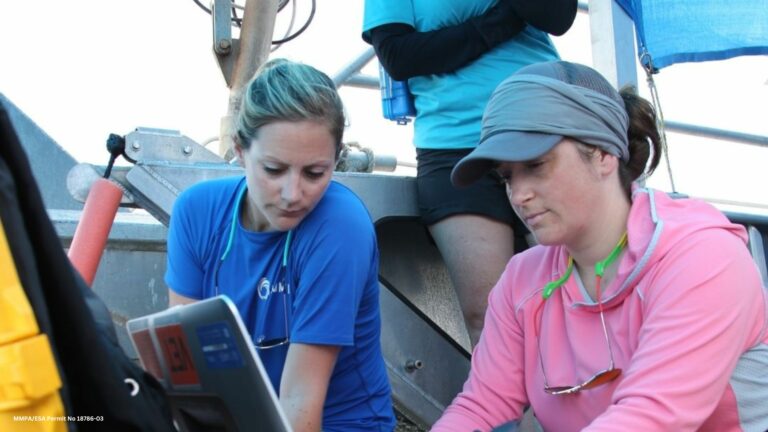For Immediate Release
Contact: st**********@**mf.org
First-ever Hearing Tests to Inform Ways of Better Protecting Baleen Whales
Working to protect baleen whales around the world, a group of international researchers is preparing for the next phase of a critical project to test the hearing of minke whales off the coast of Norway. The National Marine Mammal Foundation (NMMF), in collaboration with the Norwegian Defense Research Establishment (FFI), is leading the effort to acquire the first audiogram (hearing sensitivity curve) for a baleen whale. The research will provide the first-ever direct measures of hearing in any baleen whale and will be an important step toward addressing a knowledge gap that is critical to protecting baleen whales from man-made ocean noise.
The ground-breaking research has the support and attention of some of the world’s leading marine mammal scientists. It is funded by the U.S. President’s Subcommittee on Ocean Science and Technology (SOST) Interagency Working Group on Ocean Sound and Marine Life, which consists of multiple agencies including the U.S. Office of Naval Research, Bureau of Ocean Energy Management, National Oceanic and Atmospheric Administration, Navy Living Marine Resources, and the Marine Mammal Commission.
“Understanding what a whale can hear is the first step in determining what kinds of man-made ocean noise might negatively affect them. This knowledge ultimately helps all kinds of ocean-related industries in the development of measures to protect the whales from noise that could be harmful to these animals,” said Dr. Dorian Houser, one of the project’s lead researchers.
The research is taking place in northern Norway during the late spring and early summer months. During this time, the minke whale, the smallest of the baleen whales, migrates northward to Arctic waters. The research team will carefully and safely perform catch-and-release studies in which adolescent minke whales will be caught in a natural body of water and monitored under the supervision of experienced marine mammal veterinarians. Each whale will have its hearing tested by using a non-invasive method, the same one used to test a human newborn baby’s hearing. After the test, the whale will be released to continue its migration.

Over the last century, humans have increasingly put sound into the ocean. Human-made (anthropogenic) sound is intentionally used to explore the ocean floor, to search for oil, in scientific research, in fisheries and for navigation and military purposes, like sonar. A dramatic increase in the use of cargo ships for transporting commercial goods and a proliferation of recreational vessels have also contributed to an increase in ocean noise in many parts of the world.
“Man-made sound can potentially affect a whale’s hearing, change its behavior, and interfere with its ability to communicate, look for food, and navigate. It can potentially hinder a baleen whale’s ability to hear and avoid ships, and we believe chronically high levels of sound might elevate levels of stress hormones that affect a whale’s health and ability to reproduce,” said Dr. Petter-Helgevold Kvadsheim, Norway’s lead researcher on the project.
Because sound travels efficiently through water, sounds produced in the ocean can travel great distances and can even be detected thousands of miles from the source, in some instances. Baleen whales rely on sound to communicate, forage, and navigate the world’s oceans. Many baleen whales are endangered and their rates of producing calves are low, so there is reasonable concern as to how anthropogenic noise might affect these whales and their populations.
Dr. Jonas Teilmann, a Danish professor of Marine Mammal Science at Aarhus University, praised the project’s careful planning. “The approach to temporarily catching wild minke whales in Lofoten, Norway, is very promising,” said Dr. Teilmann. “It is my clear impression that there is a high chance of successfully catching a small whale and safely carrying out the hearing test. This project is by far the best planned attempt to catch a wild, healthy baleen whale and the highly-skilled team of marine mammal biologists and veterinarians are best-suited to ensure the wellbeing of the whale during the relatively short duration of the experiment.”
The hearing tests will be conducted by NMMF scientists, who have extensive experience in performing these types of tests and are world leaders in the study of marine mammal hearing. Scientists are focusing on adolescent minke whales for the study, which range from three to five meters in length and are similar in size to adult belugas, a type of toothed whale, for which the hearing test method has been successfully used many times. Testing with smaller individuals makes handling a whale easier and safer and increases the chances of successfully performing the hearing tests.
Whales will be temporarily caught between two small islands that the whales are known to pass between on their migration, an ideal and quiet location for the hearing tests. Once a whale passes between the islands, the entrances will be closed with nets. The waterway is large and a whale will have plenty of room to freely swim and dive while contained between the islands. After the marine mammal veterinarians have observed the whale and made a decision that it is healthy for testing, another net will be deployed between two boats and used to direct the whale into a modified fish farm. Once in the fish farm, the nets of the fish farm can be pulled up from beneath the whale to create a hammock for the whale in the water. Other marine mammals have been safely studied using similar catch-and-release methods and no long-term effects are expected. Each whale that has its hearing tested will be fitted with a satellite tag prior to its release. This will allow researchers to monitor the whale for several months after testing to ensure that it continues its normal migration.
Information obtained from this study will be used by federal regulatory agencies, scientists and conservationists to improve the management of ocean noise issues and their potential impacts to all baleen whales, including six species that are classified as endangered.
###





